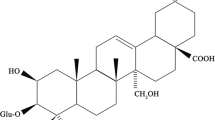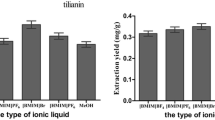Abstract
The ultra performance liquid chromatography (UPLC) and high performance liquid chromatography (HPLC) method was developed and compared to detect the trans-10-hydroxy-2-decenoic acid (10-HDA) content in royal jelly cream and lyophilized powder. The sample was extracted using absolute ethanol based on the ultrasound-assisted extraction. Chromatographic separation of 10-HDA and methyl 4-hydroxybenzoate as internal standard was carried out on a Nova-pak® C18 column for HPLC and on Acquity BEH C18 column for UPLC. In the HPLC system, the average recoveries were 95.0–99.2% (n = 5) with relative standard deviation (RSD) values of 1.1–2.1% for royal jelly cream and 98.0–100.0% (n = 5) with RSD values of 1.6–3.0% for lyophilized powder, respectively. The limit of detection (LOD) and limit of quantitation (LOQ) were 0.5 and 1.5 mg kg−1 for both royal jelly cream and lyophilized powder. In the UPLC system, the limit of detection (LOD) and limit of quantitation (LOQ) were 0.3 and 1.0 mg kg−1 for both royal jelly cream and lyophilized powder. The major advantages of UPLC, using 1.7 μm particles, over HPLC are the speed of analysis, the narrower peaks and the decrease of solvent consumption for the 10-HDA in the analyses of beeproducts. The two methods were validated for the determination of practical royal jelly products. The concentration of 10-HDA ranges from 1.26 to 2.25% for pure royal jelly cream samples and 3.01–6.26% for royal jelly lyophilized powder samples. For 30 royal jelly products, the 10-HDA content varied from no detectable to 1.005%.




Similar content being viewed by others
References
Münstedt K, von Georgi R (2003) Am Bee J 43:647–650
Wang GY, Lin ZB (1996) Chin J Pharm Toxicol 1:53–55
Rembold H (1965) Vitam Horm 23:359–382
Iannuzzi J (1990) Am Bee J 130:587–589
Inoue SI, Koya-Miyata S, Ushio S, Iwaki K, Ikeda M, Kurimoto M (2003) Exp Gerontol 38:965–969
Dixit PK, Patel NG (1964) Nature 202:189–190
Kramer KJ, Tager HS, Childs CN, Speirs RD (1977) J Insect Physiol 23:293–295
Fujii A, Kobayashi S, Kuboyama N, Furukawa Y, Kaneko Y, Ishihama S, Yamamoto H, Tamura T (1990) Jpn J Pharmacol 53:331–337
Townsend GF, Morgan JF, Hazlett B (1959) Nature 183:1270–1271
Townsend GF, Morgan JF, Tolnai S, Hazlett B, Morton HJ, Shuel RW (1960) Cancer Res 20:503–510
Barker SA, Foster AB, Lamb DC, Hodgson N (1959) Nature 183:996–997
The Ministry of Agriculture of P.R.C. (2002) Nuisanceless food—the quality standard of royal jelly and lyophilized powder
Bloodworth BC, Harn CS, Hock CT (1995) J AOAC Int 78:1019–1023
Dai F, Li L (1990) Chin J Pharm Anal 10:108–109
Zhang X, Fu CY, Yang RF (1989) Chem J Chin Univ 10:609–613
Genc. M, Aslan A (1999) J Chromatogr A 839:265–268
Long ZX, Wan CH, Wang K, Liu BP, Hu HS (2005) Chin Food Sci 26:170–172
Chen XP, Ni L, Zhao DH (2005) Pract Prev Med 12:172–172
Swartz ME (2005) LC-GC North Am 23:8–14
Ultra Performance LCTM by design, Waters Corporation, USA, 720000880EN LL&LW-UL (2004)
Luque de Castro MD, Da Silva MP (1997) Trends Analyt Chem 16:16–24
Pacakova V, Štulik K, Jiskra J (1996) J Chromatogr A 754:17–31
Hercegova A, Domotorova M, Matisova E, Kirchner M, Otrekal R, Stefuca V (2005) J Chromatogr A 1084:46–53
Author information
Authors and Affiliations
Corresponding author
Rights and permissions
About this article
Cite this article
Zhou, J., Zhao, J., Yuan, H. et al. Comparison of UPLC and HPLC for Determination of trans-10-Hydroxy-2-Decenoic Acid Content in Royal Jelly by Ultrasound-Assisted Extraction with Internal Standard. Chroma 66, 185–190 (2007). https://doi.org/10.1365/s10337-007-0305-8
Received:
Revised:
Accepted:
Published:
Issue Date:
DOI: https://doi.org/10.1365/s10337-007-0305-8




